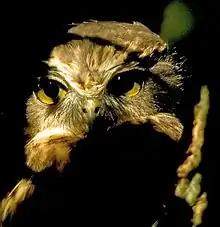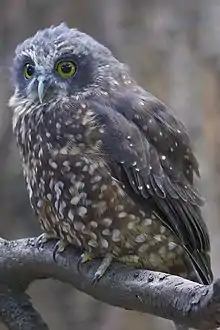Morepork
The morepork (Ninox novaeseelandiae), also called the ruru or Tasmanian spotted owl, is a small brown owl found throughout New Zealand and Tasmania. Described by Johann Friedrich Gmelin in 1788, it was for many years considered to be the same species as the Australian boobook of mainland Australia until 1999. Its name is derived from its two-tone call. Four subspecies of the morepork are recognized, one of which is extinct and another that exists only as a hybrid population. The bird has almost 20 alternative common names, including mopoke and boobook—many of these names are onomatopoeic, as they emulate the bird's distinctive two-pitched call.[2]
| Morepork | |
|---|---|
 | |
| Morepork in New Zealand | |
| Scientific classification | |
| Kingdom: | Animalia |
| Phylum: | Chordata |
| Class: | Aves |
| Order: | Strigiformes |
| Family: | Strigidae |
| Genus: | Ninox |
| Species: | N. novaeseelandiae |
| Binomial name | |
| Ninox novaeseelandiae (Gmelin, 1788) | |
It has dark brown plumage with prominent pale spots, and golden-yellow eyes. It is generally nocturnal, though sometimes active at dawn and dusk, retiring to roost in secluded spots in the foliage of trees. The morepork feeds on insects and small vertebrates, hunting by pouncing on them from tree perches. The International Union for Conservation of Nature has assessed the morepork as being of least concern on account of its large range and apparently stable population.[3]
Taxonomy
English naturalist John Latham wrote of the New Zealand owl in his 1782 work A General Synopsis of Birds, but did not give it a binomial name.[4] German naturalist Johann Friedrich Gmelin described the morepork in 1788.[5]
"Morepork" has been designated the official name by the International Ornithological Committee.[6]
Both Gerlof Fokko Mees and Ernst Mayr regarded the taxonomy of the boobook owl as extremely challenging,[7] the latter remarking in 1943 that it was "one of the most difficult problems I have ever encountered".[8] In his 1968 book Nightwatchmen of the Bush and Plain, Australian naturalist David Fleay observed that the boobooks from Tasmania more closely resembled those of New Zealand than those from mainland Australia, though he followed Mees in treating them as a single species.[9]
Janette Norman and colleagues tested the cytochrome b DNA of three subspecies (as well as the powerful and rufous owls) to ascertain whether the closest relative was used in breeding with the last surviving female of the Norfolk boobook. They discovered that although the Norfolk boobook was similar in plumage to the Tasmanian boobook, it was genetically much closer to the New Zealand subspecies. In fact, the two were so close genetically that they considered whether the Norfolk boobook should be recognised as a separate taxon at all, although they conceded the two were easily distinguishable in appearance, so maintained the three as subspecies; the Tasmanian boobook only diverged by 2.7% from the other two, while the powerful and rufous owls diverged by 4.4% from each other.[10] Leading from this, the Australian boobook was split from the Tasmanian boobook and morepork in volume 5 of the Handbook of the Birds of the World; however, several authors, including Les Christidis and Walter Boles, contested that the data had been misinterpreted from the Norman study, which had not sampled any Australian mainland boobooks at all. They treated the three taxa (southern, Tasmanian boobooks, and moreporks) as a single species.[11]
Examining both morphological and genetic (cytochrome b) characters, Michael Wink and colleagues concluded that the Australian boobook was distinct from the morepork, as was the Tasmanian boobook, which should be raised to species status as Ninox leucopsis.[12]
Subspecies
Four subspecies of Ninox novaeseelandiae are recognised by the IOC, two of which are extinct:[6]
- N. n. albaria, the Lord Howe boobook, vanished from Lord Howe Island in the 1950s.
- N. n. leucopsis, the Tasmanian boobook, is found across Tasmania.
- N. n. novaeseelandiae, the nominate subspecies, is found in the North and South Islands of New Zealand.
- N. n. undulata, the Norfolk boobook, exists only as a small hybrid population after the last surviving female disappeared in 1996. It was paired with introduced moreporks from New Zealand while it lived.
Description
The morepork is 26 to 29 cm (10 to 11.5 in) long, with the female slightly larger than the male. Females are slightly heavier at 170–216 g (6.0–7.6 oz) compared with the male's 140–156 g (4.9–5.5 oz).[13] The morepork has generally dark brown head and upperparts, with pale brown spots on head and neck and white markings on the rest of the upperparts, with a pale yellow-white supercilium (eyebrow), dark brown ear coverts, and buff cheeks.[14] The eyes are yellow to golden-yellow.[15] The feathers of the chin and throat are buff with dark brown shafts. The feathers of the underparts are mostly dark brown with buff and white spots and streaks, with the larger markings on the belly making it look paler overall. The upper tail is dark brown with lighter brown bars.[14] The cere and bill is pale blue-grey with a black cutting edge. The feet are orange or yellow with blackish claws.[15]
Young moreporks do not attain adult plumage properly until their third or fourth year.[14] The tips of juvenile's feathers are white and fluffy, remnants of the nestlings' down. These are worn away over time, persisting longest on the head. The feathers of the head, neck, and underparts are fluffier overall. Their plumage is a darker and more greyish brown overall than that of adults.[16]
Distribution and habitat
In New Zealand's North Island, it is common from Rangaunu Harbour south to southern Taranaki and west of Tauranga, Lake Taupo, and Whanganui, as well as between Murupara and Hangaroa in the northeast, and southern Manawatu, Wellington, and Wairarapa in the south, and uncommon outside these areas. In the South Island, it is more common west of the Southern Alps, around Marlborough and in Southland. It is common on Stewart Island and offshore islands.[17]
It is widespread in Tasmania and on King Island and other islands of Bass Strait.[17] It has been recorded in southern Victoria, and once from New South Wales.[18]
It occurs in most habitats with trees, in Tasmania predominantly eucalypt forests and in New Zealand forests dominated by Podocarpus, Nothofagus, Metrosideros, and other hardwoods, up to the alpine tree line. On Norfolk Island, it lives in forests of Norfolk Island pine (Araucaria heterophylla).[19]
Behaviour
They are usually seen singly, in pairs, or in small family groups of an adult pair and up to three young.
Swamp harriers could feasibly prey on young moreporks.[14]
During the day, moreporks sleep in roosts. Although mainly nocturnal, they are sometimes active at dawn and dusk. The main hunting times are evenings and mornings, with brief bursts of activity through the night. On dark nights, they often perch through the middle hours, and particularly if the weather is bad, may hunt by daylight, instead.
Breeding
.jpg.webp)
Moreporks nest anywhere the trees are large enough to have hollows.[19]
Feeding
Although their main hunting technique is perch-and-pounce, they are agile birds with a swift, goshawk-like wing action and the ability to maneuver rapidly when pursuing prey or hawking for insects.
They hunt a variety of animals – mainly large invertebrates including scarab and huhu beetles, moths and caterpillars, spiders, grasshoppers, and in New Zealand, wētā. They also take almost any suitably sized prey, particularly small birds, rats, and mice. They can find suitable food in pine forests as well as native forest.
Conservation status
A widespread and generally common species, morepork is listed as being a species of least concern by the International Union for Conservation of Nature, on account of its large range and stable population, with no evidence of any significant decline.[1] Like most species of owls, the morepork is protected by the Convention on International Trade in Endangered Species of Wild Fauna and Flora with its placement on the Appendix II list of vulnerable species, which makes the import, export, and trade of listed wild-caught animals illegal.[20]
Gallery
.jpg.webp) Feathers from N. novaeseelandiae in the collection of Auckland Museum
Feathers from N. novaeseelandiae in the collection of Auckland Museum N. novaeseelandiae, Maungatautari Mountain
N. novaeseelandiae, Maungatautari Mountain N. novaeseelandiae, Kiwi Birdlife Park, Queenstown
N. novaeseelandiae, Kiwi Birdlife Park, Queenstown
References
- BirdLife International (2016). "Ninox novaeseelandiae". IUCN Red List of Threatened Species. 2016: e.T62023843A95186187. doi:10.2305/IUCN.UK.2016-3.RLTS.T62023843A95186187.en.
- Burnie, David (2012). Nature Guide: Birds. New York: Penguin. p. 199. ISBN 978-0-7566-9862-1.
- "Ninox novaeseelandiae (Morepork)". IUCN Red List of Threatened Species. Retrieved 19 June 2018.
- Latham, John (1782). A General Synopsis of Birds. 1. London, United Kingdom: Benj. White. pp. 149–50.
- Gmelin, Johann Friedrich (1788). Systema naturae per regna tria naturae :secundum classes, ordines, genera, species, cum characteribus, differentiis, synonymis, locis /Caroli a Linné. Leipzig, Germany: Impensis Georg. Emanuel. Beer. p. 296.
- Gill, Frank; Donsker, David, eds. (2017). "Owls". World Bird List Version 7.3. International Ornithologists' Union. Retrieved 28 October 2017.
- Mees, Gerlof Fokko (1964). "A revision of the Australian owls (Strigidae and Tytonidae)". Zoologische Verhandelingen. 65: 3–62.
- Mayr, Ernst (1943). "Notes on Australian Birds (II)". Emu. 43 (1): 3–17. doi:10.1071/MU943003.
- Olsen, Jerry (2011). "What is a Southern Boobook?". Australian High Country Owls. Collingwood, Victoria: CSIRO. pp. 15–17. ISBN 9780643104112.
- Norman, Janette; Olsen, Penny; Christidis, Les (1998). "Molecular genetics confirms taxonomic affinities of the endangered Norfolk Island Bookbook Owl Ninox novaeseelandiae undulata". Biological Conservation. 86 (1): 33–36. doi:10.1016/S0006-3207(98)00012-3.
- Christidis, Les; Boles, Walter (2008). Systematics and taxonomy of Australian birds. Collingwood, Victoria: CSIRO Publishing. p. 165. ISBN 978-0-643-06511-6.
- Michael Wink; Petra Heidrich; Hedi Sauer-Gürth; Abdel-Aziz Elsayed & Javier Gonzalez (2008). "Molecular phylogeny and systematics of owls (Strigiformes)". In König, Claus & Weick, Friedhelm (eds.). Owls of the World (2nd ed.). A&C Black. pp. 42–63. ISBN 9781408108840.
- König, Claus; Weick, Friedhelm; Becking, Jan-Hendrik (2009). Owls of the World. Helm Identification Guides. A&C Black. pp. 455–56. ISBN 9781408108840.
- Higgins 1999, p. 867.
- Higgins 1999, p. 869.
- Higgins 1999, p. 868.
- Higgins 1999, p. 855.
- Higgins 1999, p. 872.
- Higgins 1999, p. 854.
- "Appendices I, II and III". CITES. 22 May 2009. Archived from the original on 17 March 2010. Retrieved 18 March 2010.
Cited texts
- Higgins, P.J. (1999). Handbook of Australian, New Zealand and Antarctic Birds. Volume 4: Parrots to Dollarbird. Melbourne, Victoria: Oxford University Press. ISBN 0-19-553071-3.
External links
| Wikimedia Commons has media related to Ninox novaeseelandiae. |
| Wikispecies has information related to Ninox novaeseelandiae. |
| Look up morepork in Wiktionary, the free dictionary. |
- Wingspan Birds of Prey Trust
- Photos, audio and video of morepork from Cornell Lab of Ornithology's Macaulay Library

